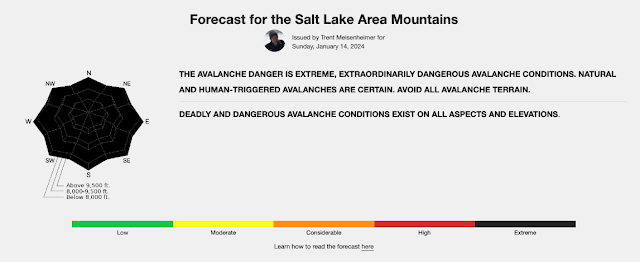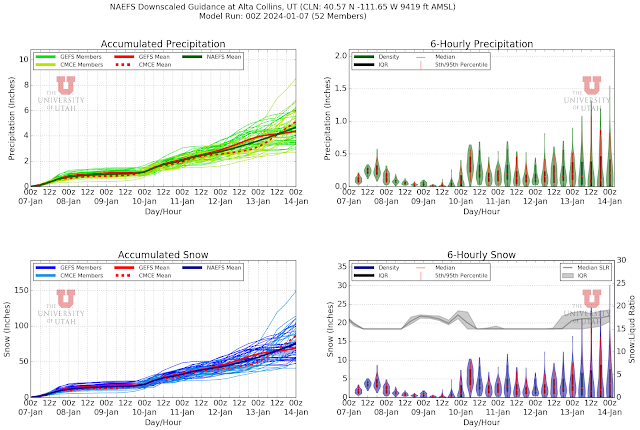I thought for today we could talk about how much snow we might get from this storm cycle.
A storm cycle is a series of storms that occur in succession. One has to decide when to start or end such a cycle. There are two options for this one. One is to start on January 4th, which is when we first started seeing snow after the holiday drought. The other is to start yesterday, January 9, as there was nearly a 24-hour break in the snow.
I'll use both here.
Jan 4 start: 38.5" so far (per Alta Snowfall History)
Jan 9 start: 13" so far (per Collins automated measurements)
These are a little inconsistent because the Collins automated measurements don't perfectly correspond to the snowfall history, but this is only for fun and we're not running a professional gambling house here, so I'll go with it.
How much will we add to these totals? For the purposes of defining and end, I'm going to use 1200 UTC 15 January (5 AM MST Monday) as most models suggest there may be a break then.
Let's start with the GFS. After deducting what it produced overnight last night, the GFS is producing an additional 4.85" of water and 67.8" of snow for Alta through 5 AM MST Monday.
We don't have a comparable product for the Euro, but it is coming in with about 3.2" of water which if we use the mean snow-to-liquid ratio from the GFS converts to about 45" of snow. The Euro does tend to be the drier of the two models for Alta.
Finally, we have the downscaled NAEFS. I've never seen numbers like these being output from this product. Across the whole western US, the mean bias of the water equivalent forecasts produced by this technique is close to zero, but my impression is that it is typically high for Alta (but I haven't confirmed this). Additionally, this uses an old and very simplistic algorithm for snow-to-liquid ratio, and in a situation like this with strong winds and high water equivalents, it is probably overestimating the snow-to-liquid ratio during some parts of the storm. That said, after deducting about 1" of water equivalent at 15" of snow it called for overnight, the NAEFS mean calls for another 7" of water and 100+ inches of snow.

After looking over the models for the period, I consider the real crux for these forecasts to be the period from tonight, when we will be in the unstable postfrontal flow, and then Friday when we transition to a more stable northwesterly flow with high integrated vapor transport. The GFS forecast for the latter is depicted below.
These are environments where I see a wider range of possible outcomes, unlike today, especially this afternoon, when it looks like it is a lock to get the goods with the frontal approach and passage. Then there's the big storm system for the weekend, which is associated with an intense and compact upper-level trough and inland penetrating atmospheric river.
These are amongst the most exciting forecasts I've seen in my time at Utah. We have had big storm cycles, but the number of models calling for big accumulations in the mountains and periods of disruptive snowfall in the valleys is remarkable.
So how high does one go for the rest of the storm cycle? For an over under, I'm going to go a bit below the GFS total and add another 60" to what we have already. That puts us at
Jan 4 start: 38.5"+60" = 98.5"
Jan 9 start: 13"+ 60" = 73"
Another way to think about the over under is that it represents the middle point of all of the possibilities. There's a 50% chance of less and a 50% chance of more.
The National Weather Service would have access to an objectively determined "over under" from their National Blend of Models. Perhaps someone from there can share it in the comments below. For what it is worth, what the call the "deterministic" forecast from this product is calling for a bit over 80".
 |
| NBM forecast for Alta screenshot at 10:16 AM MST 10 January 2024 |
I confess that my 60" above could reflect my conservative nature. I have a hard time going way out on the limb for the most extreme storms.
In the end, we will get what we get and we won't throw a fit. We are going get it today and over the weekend and possibly quite a bit in between. It is going to add up to a lot of snow, big traffic snarls, dangerous avalanche conditions, terrain closures, etc. etc. etc.
Are you over or under?





















































